Cultivation of Populus tomentosa
Yellow poplar, also known as oolong, evergreen, evergreen, terrestrial plants, let's take a look at the planting and cultivation of yellow poplar.

Populus tomentosa belongs to shrubs or small trees, 1-6 m high; branches cylindrical, longitudinally angled, gray-white; branchlets quadrangular, completely pubescent or outer opposite sides glabrous, internodes 0.5-2 cm long.
Leaves leathery, broadly elliptic, broadly Obovate, ovate-elliptic or oblong, most 1.5-3.5 cm long and 0.8-2 cm wide, apex round or obtuse, often with small notches, not sharp, base round or acute or cuneate, leaf surface bright, midvein protruding, lower half often finely hairy, lateral veins obvious, dorsal midvein flat or slightly protruding, midvein often densely covered with white short-line stalactites, no lateral veins Petiole 1-2 mm long, hairy above.
Inflorescences axillary, capitate, densely flowered, inflorescence rachis 3-4 mm long, hairy, bracts broadly ovate. 2-2.5 mm long, back hairy; male flowers about 10, sessile, outer sepals ovate-elliptic, inner sepals suborbicular, 2.5-3 mm long, glabrous, stamens with anthers 4 mm long, sterile pistils clavate stalks, ends dilated, about 2 mm high (height is about 2 canes or as long as sepals) Female sepals 3 mm long, ovary slightly longer than style, glabrous, style coarsely flattened, stigma obcordate, extending to middle of style. The florescence is in March. Capsule subglobose, 6-8 (- 10) mm long, persistent style 2-3 mm long. The fruit period is from May to July.

Growth habits of Populus tomentosa
Populus tomentosa grows mostly in high mountains, steep cliffs and mountainous and stony places. Shade-resistant, like warm and humid climate, many valleys, streams, under the forest, elevation 1200-2600 meters, terrestrial woody plants. It is resistant to overcast and light, and can maintain good growth under general indoor and outdoor conditions.
In the long-term shady environment, although the leaves can remain green, it is easy to lead to excessive growth or weakening of branches. Like moist, can withstand the cloudy and rainy weather for about a month, but avoid stagnant water for a long time. Drought tolerance, as long as the surface soil or basin soil is not completely dry, there is no abnormal performance.
Heat-resistant and cold-resistant, it can withstand summer exposure and the severe cold of minus 20 degrees Celsius, but it should be ventilated and transparent when it is hot and humid in summer. Loose requirements for soil, easy and fertile sandy loam is better, potted can also be used with vermiculite, peat or soil, strong alkali resistance.
Strong tillering, resistant to pruning, easy to shape. Can change the pot or transplant in four seasons, summer or new bud germination should pay attention to shade and prevent the basin soil from getting too wet, otherwise it is easy to cause the original leaves to defoliate. After sufficient light and dormancy in autumn, the leaves can turn red.

Propagation methods of Populus tomentosa
Sowing and reproduction
The seeds of Populus tomentosa, which mature from September to October, are harvested and dried, sown in a deep and fertile open field and allowed to freeze in the sun with frost. After applying thicker liquid fertilizer in the early spring of the next year, the seeds are covered with thin soil to keep the soil moist, and begin to sprout and grow seedlings in the Spring Equinox's season. The seedlings of Populus tomentosa grow slowly and can be divided into different plants when they grow to 3-4 cm. Seedlings need 4-5 years of vegetative growth before they can blossom and bear fruit. General flower growers in the few years after flowering, always take off all the buds, reduce nutrient consumption, promote vegetative growth, take its natural growth, a little pruning, it will soon form a spherical umbrella crown, beginning to have ornamental value.

Cuttage propagation
Cuttage is the main method of propagation of boxwood. The time should be in March in spring or August in autumn, with the stem of seedlings as cuttings, with top buds about 7 cm long, all the lower branches and leaves should be cut off, and the upper leaves should be retained. In order to promote the rooting of cuttings, 0.01010 naphthalene acetic acid aqueous solution can be used to soak the base of cuttings about 2.5 cm long for 15-20 hours, then insert them into sandy soil at a depth of 3 cm, and spray water once with a fine hole spray pot after insertion. At the same time, it is necessary to set up a shed to block the sun, keep the soil moist, and often spray water to the leaves to increase air humidity and keep parsley from wilting.
These are all the contents of the planting and cultivation of yellow poplar that I have summarized for you. I hope this article can help you. Please continue to follow us.
Related
- Wuhan Hospital Iron Tree Blooming Result Was Instantly Frightened by the Gardener Master
- Which variety of camellia is the most fragrant and best? Which one do you like best?
- What is the small blue coat, the breeding methods and matters needing attention of the succulent plant
- Dormancy time and maintenance management of succulent plants during dormancy
- Minas succulent how to raise, Minas succulent plant pictures
- What are the varieties of winter succulent plants
- How to raise succulent plants in twelve rolls? let's take a look at some experience of breeding twelve rolls.
- Attention should be paid to water control for succulent plants during dormant period (winter and summer)
- Watering experience of twelve rolls of succulent plants
- Techniques for fertilizing succulent plants. An article will let you know how to fertilize succulent plants.



